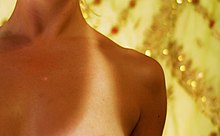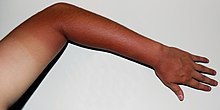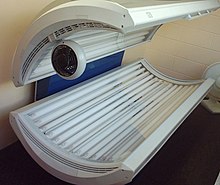Sun tanning

Sun tanning or tanning is the process whereby
Impact on skin health


Moderate exposure
Moderate exposure to direct sunlight contributes to the production of melanin and vitamin D by the body.[citation needed]
Excessive exposure
Excessive exposure to ultraviolet rays has negative health effects, including
Long-term
Excessive exposure may in the long-term increase the risk of skin cancer,[3] as well as depressed immune system function and accelerated aging of the skin.[4]
Tanning process

There are two different mechanisms involved in the production of a tan by UV exposure: Firstly, UVA radiation creates oxidative stress, which in turn oxidizes existing melanin and leads to rapid darkening of the melanin. UVA may also cause melanin to be redistributed (released from melanocytes where it is already stored), but its total quantity is unchanged. Skin darkening from UVA exposure does not lead to significantly increased production of melanin or protection against sunburn.
UVA
Ultraviolet A (UVA) radiation is in the wavelength range 320 to 400 nm.[11] It is present more uniformly throughout the day, and throughout the year, than UVB. Most UVA is not blocked by the atmosphere's ozone layer. UVA causes the release of existing melanin from the melanocytes to combine with oxygen (oxidize) to create the actual tan color in the skin.[citation needed] UVA is blocked less than UVB by many sunscreens, but is blocked to some degree by clothing. UVA is known both to cause DNA damage and to be carcinogenic. However, it operates not by inducing direct DNA damage, but by producing reactive oxygen species which damage DNA indirectly. UVA (see above) induces a cosmetic tan but little extra melanin protection against sun damage, sun burn, or cancer.[citation needed]
UVB
Ultraviolet B (UVB) radiation is in the wavelength range 280 to 320 nm. Much of this band is blocked by the Earth's ozone layer, but some penetrates. UVB:
- triggers the formation of
- is more likely to cause a sunburn than UVA as a result of overexposure. The mechanism for sunburn and increased melanogenesis is identical.[12] Both are caused by the direct DNA damage (formation of CPDs).
- produces Vitamin D in human skin.
- is reduced by virtually all sunscreens in accordance with their SPF.
- is thought, but not proven, to cause the formation of moles and some types of skin cancer.
- causes skin aging (but at a slower rate than UVA).[citation needed]
- stimulates the production of new melanin, which leads to an increase in the dark-colored pigment within a few days.[13]
Tanning behavior of different skin colors
A person's natural skin color affects their reaction to exposure to sunlight. An individual's natural skin color can vary from a dark brown to a nearly colorless pigmentation, which may appear white. In 1975, Harvard dermatologist Thomas B. Fitzpatrick devised the Fitzpatrick scale which described the common tanning behavior of various skin types, as follows:[14][15]
| Type | Also called | Sunburning | Tanning behavior | von Luschan scale
|
|---|---|---|---|---|
| I | Very light or pale | Often | Occasionally | 1–5 |
| II | Light or light-skinned | Usually | Sometimes | 6–10 |
| III | Light intermediate | Rarely | Usually | 11–15 |
| IV | Dark intermediate | Rarely | Often | 16–21 |
| V | Dark or " brown " type |
No | Sometimes darkens | 22–28 |
| VI | Very dark or " black " type |
No | Naturally black-brown skin | 29–36 |
Health aspects


The most common risk of exposure to ultraviolet radiation is
Cultural history

In the United States and Western Europe before the 1920s, tanned skin was associated with the lower classes because they worked outdoors and were exposed to the sunlight. Parasols and long sleeves were typically worn, even at beaches.[31] By the 1920s, however, a cultural transformation took place, and tan skin became the ideal.[31]
By the early 20th century, therapeutic benefits of sunlight were advertised to the public.
In 1910 a scientific expedition went to the island of
In 1978, both sunscreen with an SPF 15 rating as well as
Sunless tanning

To avoid exposure to UVB and UVA rays, or in seasons without strong sunshine, some people take alternative steps to appear with darkened skin. They may use sunless tanning (also known as self-tanners); stainers which are based on
See also
References
- ^ Marshall, Jessica. "Gene behind tanning comes out of hiding". New Scientist. Archived from the original on 25 November 2020. Retrieved 28 October 2020.
- ^ "Scientists find why some people tan and some people burn". The Independent. 8 May 2018. Archived from the original on 25 May 2022.
- ^ "Ultraviolet (UV) Radiation". Archived from the original on 6 September 2015. Retrieved 27 August 2015.
- PMID 24838074.
- PMID 25741402.
- ISBN 978-1615353293.
- PMID 20979596.
- ^ a b Amy Thorlin (5 February 2006). "The Tanning Process". Lookingfit.com. Archived from the original on 22 July 2009. Retrieved 15 April 2015.
- ^ PMID 15748643.
- ^ "The Surgeon General's Call to Action to Prevent Skin Cancer" (PDF). U.S. Department of Health and Human Services. 2014. p. 20. Archived (PDF) from the original on 26 November 2014.
A UVB-induced tan provides minimal sun protection, equivalent to an SPF of about 3.
- ^ "ISO 21348 Definitions of Solar Irradiance Spectral Categories" (PDF). Archived (PDF) from the original on 29 October 2013.
- S2CID 38940583.
- ^ "The known health effects of UV". WHO. 1 December 2010. Archived from the original on 4 August 2012. Retrieved 1 August 2012.
- ^ Fitzpatrick TB: Soleil et peau [Sun and skin]. Journal de Médecine Esthétique 1975; 2:33-34
- ISBN 978-1-4051-4663-0.
- ^ "Reviewed Substances". ntp.niehs.nih.gov. Archived from the original on 16 December 2016. Retrieved 13 December 2016.
- PMID 9358139.
- PMID 12661961.
- PMID 1824747.
- ^ Peeples, Lynne. Study: Frequent tanning-bed use triples melanoma risk. Archived 30 May 2010 at the Wayback Machine CNN, 27 May 2010.
- PMID 16546596.
- ^ "Side effects of naltrexone observed in frequent tanners: Could frequent tanners have ultraviolet-induced high opioid levels?". pdfslide.us. Archived from the original on 7 March 2022. Retrieved 7 March 2022.
- ISBN 9789283230052. Archived from the original on 11 February 2017. Retrieved 9 February 2017.)
{{cite book}}:|website=ignored (help - ^ "Skin Cancer". www.cancer.org. Archived from the original on 17 January 2017. Retrieved 9 February 2017.
- ^ General, Office of the Surgeon. "The Surgeon General's Call to Action to Prevent Skin Cancer". www.surgeongeneral.gov. Archived from the original on 9 February 2017. Retrieved 9 February 2017.
- PMID 26098394.
- PMID 519338.
- S2CID 4345680.
- PMID 7273295.
- PMID 9233521.
- ^ ISBN 978-0-7591-0979-7. Retrieved 11 September 2009.
Harris investigated the history of the parasol... everywhere ordinary people were forbidden to protect themselves with such devices "pallid skin became a marker of upper-class status". At the beginning of the 20th Century, in the United States, lighter-skinned people avoided the sun. ... Tanned skin was considered lower class...But by the 1920s, a cultural transformation in favor of sun tanning took place.
- ^ "The Times". 25 August 1900: 1: An advertisement for a 'German Bath In Scotland' offers 'For Health and Pleasure...Pure Air and Sun Baths...'.
{{cite journal}}: Cite journal requires|journal=(help) - ^ "All Nobel Laureates in Physiology or Medicine". Nobel Media. Archived from the original on 12 May 2015. Retrieved 29 April 2015.
- ^ "The Times". 12 March 1910: 12.
{{cite journal}}: Cite journal requires|journal=(help) - ^ "The Times". 4 September 1913: 6.
{{cite journal}}: Cite journal requires|journal=(help):Describing a visit by the Prince of Wales to the pretty town of Sigmaringen the reporter says: ‘The Castle possesses many delightful terraces which could be adapted for sunbathing.’ - ^ Hanson, Peter G. (22 June 2009). "About Face". The Effects of Aging, Health and Stress on Your Face. FaceMaster. Archived from the original on 23 April 2012.
{{cite web}}: CS1 maint: unfit URL (link) - ^ "Sun and Clouds: The Sun in History". Magic Bullets - Chemistry vs. Cancer. The Chemical Heritage Foundation. 2001. Archived from the original on 20 June 2010.
By the 1920s, the therapeutic effect of the sun was widely promoted, and two well-publicized French personalities gave "tanning" a fashion boost. Coco Chanel, of designer fame, returned to Paris after a cruise on the Duke of Westminster's yacht with a tan that became all the rage. And the natural caramel skin color of singer Josephine Baker made women all over the world try to emulate her skin tone.
{{cite web}}: CS1 maint: unfit URL (link) - ISBN 978-0-7385-4415-1. Retrieved 11 September 2009.
In 1920s France, the caramel-skinned entertainer Josephine Baker became a Parisian idol. Concurrently, fashion designer Coco Chanel was "bronzed" while cruising on a yacht. A winter tan became a symbol of the leisure class and showed you could afford to travel to exotic climates.
- ISBN 978-1847885630.
- ^ "Sunscreen Lotion, Spray & Sun Care Products - Coppertone® - Coppertone®". www.coppertone.com. Archived from the original on 26 October 2016. Retrieved 1 May 2018.
- ISBN 978-1-4391-5585-1.
- ISBN 978-94-007-2048-0.
- ISBN 978-0-520-25153-3.
- ^ Wright, Dan (16 August 2007). "Working The Tan". The Daily News-Record. Harrisonburg, Virginia. Archived from the original on 20 April 2010. Retrieved 11 September 2009.
The tanning industry has grown about 25 percent over the past six years, according to the Indoor Tanning Association. In the United States, about 25,000 free-standing tanning salons employ 160,000 people and generate more than $5 billion in annual revenue, the association said.
- ^ Clark, Patrick (5 October 2016). "Twilight of the Tanning Salons". Bloomberg News. Archived from the original on 10 October 2016. Retrieved 9 October 2016.
- ^ Levin, Dan (3 August 2012). "Beach Essentials in China: Flip-Flops, a Towel and a Ski Mask". The New York Times. Archived from the original on 5 August 2012. Retrieved 5 August 2012.
- ^ Taylor, Angela (17 October 1969). "Tan-Through Fabric Lets Sun Shine In". The New York Times. p. 55. Archived from the original on 12 October 2013. Retrieved 30 November 2014.
- ^ "Scorecard: No nudes is good news". Sports Illustrated. 1 September 1969. Archived from the original on 12 October 2013.
permits 40% of the sun's ultraviolet rays
{{cite news}}: CS1 maint: unfit URL (link) - ^ "Tan-tastic bikini that lets rays shine through". Daily Express. 30 May 2009. Archived from the original on 17 October 2014. Retrieved 17 September 2014.
80 per cent of UV rays... a stretchy yarn described as 'a chicken wire mesh material'
- ^ "Dihydroxyacetone". Archived from the original on 28 July 2010. Retrieved 6 July 2010.
- ^ "Sunless tanning: A safe alternative to sunbathing". Archived from the original on 16 February 2010. Retrieved 6 July 2010.
